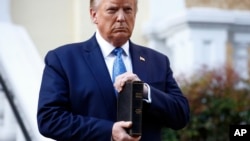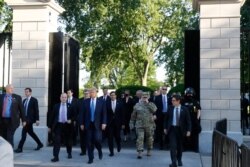U.S. President Donald Trump is defending his stroll through Lafayette Park to a historic church where he held aloft a Bible just minutes after law enforcement violently cleared the path.
Trump's actions Monday night are being harshly criticized by leaders of the Episcopal Church, including its presiding bishop, as well as prominent clergy of other Christian denominations.
"Most religious leaders loved it," Trump said Wednesday. "Why wouldn't they love it? I'm standing in front of a church that went through trauma."
Trump stated that the church, which dates to the early 19th century and has a long relationship with U.S. presidents, "received a very bad burning" during Sunday night vandalism in Washington.
A small fire in the basement of the church was quickly extinguished, according to the D.C. Fire Department.
Trump, in a Wednesday morning call-in chat to Fox News Radio, said no one had told him about the crowd of protesters along H Street Northwest, a block north of the White House, before he walked to the church.
"When I went, I didn't say, 'Oh, move them out.' I didn't know who was there."
Media reports say Attorney General William Barr, prior to the presidential procession, had ordered authorities, clad in riot gear and holding shields, to clear the way.
It is normal procedure for the Secret Service and local law enforcement to establish a cordon in areas prior to movements by any U.S. president. Monday's action, however, was aggressively unprecedented. Demonstrators and journalists were attacked, and chemical gas was unleashed.
Response from Esper
Clearing the park "was not a military decision, not a military action," Defense Secretary Mike Esper told reporters Wednesday shortly after Trump's remarks on radio.
National Guard troops were not involved in the firing of tear gas or rubber bullets at the protesters, Esper said during a Pentagon news conference.
Esper, who has been criticized for participating in what has been widely described as a political stunt, said he had not been informed before he accompanied Trump out of the White House gates that there would be such an event outside the church.
"I was not aware a photo op was happening," said Esper. "I do everything I can to stay apolitical."
Esper also told reporters he does not support invoking powers that would allow the president to order the military into states to confront civil unrest.
"The option to use active-duty forces in a law enforcement role should only be used as a matter of last resort and only in the most urgent and dire of situations," Esper told reporters. "We are not in one of those situations now. I do not support invoking the Insurrection Act."
In recent days, Trump has strongly advocated using National Guard units, which are generally under state — not federal — control except in the District of Columbia, to put a stop to acts of vandalism and looting in cities across the country.
Emphasizing "law and order," the president has demanded that more governors use the guard units at their command. He has called governors "weak" for hesitating to order a National Guard response.
Trump this week has particularly focused on violence and looting in New York City.
"If they don't get their act straightened out, I will solve it," vowed Trump in Wednesday's radio interview. "I'll solve it fast."
The president is expressing satisfaction with the enhanced deployment of federal law enforcement and the National Guard in Washington, D.C., during the past couple of nights.
Nationwide demonstrations
For eight days and nights, tens of thousands of people have protested and marched, for the most part peacefully, nationwide. In recent nights, the looting has largely abated.
The demonstrations, many of them now in defiance of local curfews, began after the death of an African American man in Minneapolis. A white police officer held George Floyd face down on the street and pressed a knee against his neck for more than eight minutes.
One officer has been arrested, and the medical examiner has ruled Floyd's death a homicide.
Groups of protesters began converging Friday night in front of the White House, and media reports said that as demonstrators confronted police, Trump was taken to a bunker as a security precaution.
"I wasn't down" in the bunker on Friday night, Trump said in the radio interview. "I went down during the day and I was there for a tiny short period of time, essentially to conduct an inspection," which he said he has done several times in the past.
Asked by Fox News Radio program host Brian Kilmeade how racial injustice in America can be solved, the president replied it is a "sad problem" but he offered no specifics on a federal response.
"Police departments have to do better," Trump said regarding distrust of law enforcement in the black community. "Everybody has to do better."













